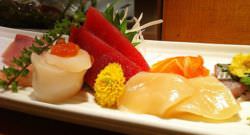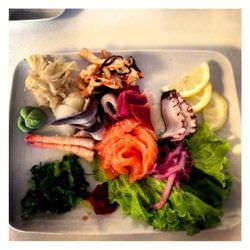Nigiri ist eine spezielle Art von Sushi, die aus einer Scheibe rohem Fisch über gepresstem Essigreis besteht. Sashimi bezieht sich nur auf Scheiben von sehr frischem Fisch oder Fleisch, die roh serviert werden, oft über einem Bett aus zerkleinertem Daikon-Rettich. Entgegen der landläufigen Meinung ist Sashimi kein Sushi , obwohl an allen Sushi-Orten immer Sashimi auf der Speisekarte steht.
Contents
Vergleichstabelle
| Nigiri | Sashimi | |
|---|---|---|
| Einführung | Nigiri ist eine Art Sushi, das aus dünnen Scheiben rohen Fisches über gepresstem Essigreis hergestellt wird. | Sashimi is thinly sliced raw meat—usually fish, such as salmon or tuna—that is served without rice. |
| Is it cooked? | Mostly raw, but you do find nigiri made with cooked or seared fish | No, always raw. |
| Cuisine | Japanese | Japanese |
| Is it Sushi? | Yes | No |
| Is it always fish? | Yes – fish and other seafood such as shrimp, octopus and squid, but never meat | No, sashimi can be thin slices of meat, like beef, horse, chicken, or frog . |
| Does it have rice? | Yes | No |
| Accompanied by | Pickled ginger, wasabi and soy sauce | Pickled ginger, wasabi and soy sauce |
| Garnished with | Mostly nothing else; occasionally a sauce if the chef so fancies | Daikon radish, sisho leaves, toasted nori (seaweed), at times other sauces |
| Eaten with | Hands or chopsticks | Chopsticks |
Components
Nigirizushi, or nigiri is made with special sushi rice treated with vinegar . This vinegared rice, balled and pressed with two fingers forms the base of the nigiri. A slice of raw fish is then placed on the rice base, at times with a speck of wasabi.

Nigirizushi is usually served in pairs. Shown above is a plate of tuna and salmon nigiri
Sashimi is slices of fresh raw fish (sometimes, meat) presented with several types of garnishes. The quality of sashimi lies in the freshness of fish, the way it’s sliced, presented and garnished. Common garnishes include shredded daikon radish, shiso leaves, or toasted nori (sea weed).
Both nigiri and sashimi are accompanied with pickled ginger and wasabi with soy sauce.
Etymology
Nigiri in Japanese means two fingers ( ni = two, giri = fingers). Nigiri sushi gets its name from the rice which has to be of a very specific portion and fit on the chef’s “two fingers” when pressing. Sushi is a Japanese term that refers to anything made with vinegared rice.

Sashimi plate with various garnishes
Sashimi is a Japanese term for pierced flesh ( Sashi = pierced, mi = flesh). The term may have originated from the culinary practice of sticking the fish’s tail and fin to the slices in identifying the fish being eaten. Another possibility for the name could come from the traditional method of harvesting – ‘Sashimi Grade’ fish is caught by individual hand line. As soon as the fish is landed, it is pierced with a sharp spike and placed in a body of ice. This spiking is call the Ike Jime process.
Common types of fish
The most popular fish toppings for nigirizushi are Maguro (tuna), Sake ( salmon ), Hamachi (yellowtail), Hirame (halibut), Ebi (cooked jumbo shrimp ), Tamago (egg omelet) and Unagi (fresh water eel). These are popular because most sushi beginners find these easier on the palate. You will also often find Tako ( octopus ), Ika (squid), Kani ( crab ), Ikura (salmon roe), Awagi (abalone) and Kazunoko (herring roe), which have a distinct flavor and takes some getting used to.
Favorite fish for sashimi include Maguro ( tuna ), Sake (salmon), Hamachi (yellowtail), Tai (red snapper), Kihada (yellowfin tuna), Saba (mackerel), Tako (Octopus) and even raw red meats such as Gyuunotataki (beef), Basashi (horse) and Torisashi (chicken). Toriwasa (slightly seared chicken ), a variation of Torisashi, is also a popular Sashimi delicacy.
Making Nigiri
Most sushi first-timers curious about fresh fish find sake (salmon) nigiri the easiest and best place to begin their sushi experience. Simple, unique-tasting and very palatable, nigiri is also very simple to make. The video below walks you through how nigiri is made:
<iframe width=”450″ height=”338″ frameborder=”0″ allowfullscreen src=”https://www.youtube.com/embed/cdQzX9SR_gk?iv_load_policy=3&rel=0&start=7″></iframe>
Sashimi as an Art Form

Sashimi presented with beautiful form and garnish
Sashimi chefs take a lot of pride in presenting the right sashimi. Much as sliced raw fish looks like the simplest form of food, sashimi can be appreciated at several levels and with all senses. One of the simplest and most elegant ways to enjoy fish, sashimi is typically eaten at the start of the meal, before the heavier dishes start crowding the palate. Diners’ palates are fresher and more discerning of the nuances between each type of fish during the earlier courses of a multi-course meal. What makes sashimi an exquisite delicacy is that no two fish taste exactly the same, and even different cuts of the same fish can yield vastly different flavors and unique textures.
Sashimi chefs consider it their pride and signature creating unique sashimi through various cuts, presentations, sauces and garnishes. Below is a video tutorial on how to make a beautiful sashimi platter:
<iframe width=”640″ height=”360″ frameborder=”0″ allowfullscreen src=”https://www.youtube.com/embed/DKTZN2TeklI?iv_load_policy=3&rel=0&start=13″></iframe>
References
- Wikipedia: Sashimi
- Wikipedia:Sushi
- Nigiri Sushi – International Gourmet
- Endless Sashimi – Lifescript
- Sashimi (Pierced Meat)
- Sushi – International Gourmet